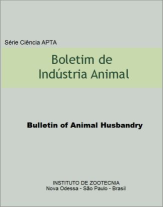Management techniques for the recovery of degraded brachiaria pastures (Brachiaria decumbens Stapf cv. Basilisk)
DOI:
https://doi.org/10.17523/bia.v72n4p331Keywords:
pasture fertilization, plant nutrition, overseeding.Abstract
The supply of nutrients is an important factor for pasture nutrition, increasing biomass productivity and improving forage quality. The correct application of fertilizers to degraded pasture areas promotes the development of forage plants and the consequent reestablishment of the culture by providing nutrients to meet the metabolic requirements of the plant. The objective of this study was to evaluate the effect of combinations of liming, fertilization and overseeding on the recovery of Brachiaria grass (Brachiaria decumbens Stapf cv. Basilisk) in an advanced stage of degradation. A randomized block design consisting of six treatments and four repetitions was used. The following treatments were evaluated: control; liming; liming + NPK; liming + NPK + FTE (fritted trace elements); liming + NPK + Zn, and liming + NPK + FTE + overseeding of Marandu grass (Brachiaria brizantha cv. Marandu). The combinations of liming and fertilization did not influence the chemical composition of the pasture. Liming + NPK + FTE + overseeding was superior in terms of biomass productivity when compared to the control treatment and did not differ from the other treatments. The mean concentrations of N, P, Ca and Mg in the aerial part of Brachiaria grass were not influenced by the fertilization combinations. Evaluation of total N export by the plant revealed a significant effect, with the liming + NPK + FTE + overseeding treatment being superior (75.76%) to the control and liming treatments, which did not differ from one another. The use of liming and fertilization, in a single application, is not sufficient to completely recover or to increase the productivity and quality of Brachiaria grass. Overseeding of Marandu grass on Brachiaria pastures, in conjunction with liming and fertilization, is a good alternative to increase the productivity and to improve the quality of pastures in an advanced stage of degradation.Downloads
Downloads
Published
Issue
Section
License
Os autores não serão remunerados pela publicação de trabalhos, pois devem abrir mão de seus direitos autorais em favor deste periódico. Por outro lado, os autores ficam autorizados a publicar seus artigos, simultaneamente, em repositórios da instituição de sua origem, desde que citada a fonte da publicação original seja Boletim de Indústria Animal. A revista se reserva o direito de efetuar, nos originais, alterações de ordem normativa, ortográfica e gramatical, com vistas a manter o padrão culto da língua e a credibilidade do veículo. Respeitará, no entanto, o estilo de escrever dos autores. Alterações, correções ou sugestões de ordem conceitual serão encaminhadas aos autores, quando necessário. Nesses casos, os artigos, depois de adequados, deverão ser submetidos a nova apreciação. As opiniões emitidas pelos autores dos artigos são de sua exclusiva responsabilidade. Todo o conteúdo deste periódico, exceto onde está identificado, está licenciado sob a Licença Creative Commons Attribution (CC-BY-NC). A condição BY implica que os licenciados podem copiar, distribuir, exibir e executar a obra e fazer trabalhos derivados com base em que só se dão o autor ou licenciante os créditos na forma especificada por estes. A cláusula NC significa que os licenciados podem copiar, distribuir, exibir e executar a obra e fazer trabalhos derivados com base apenas para fins não comerciais.













